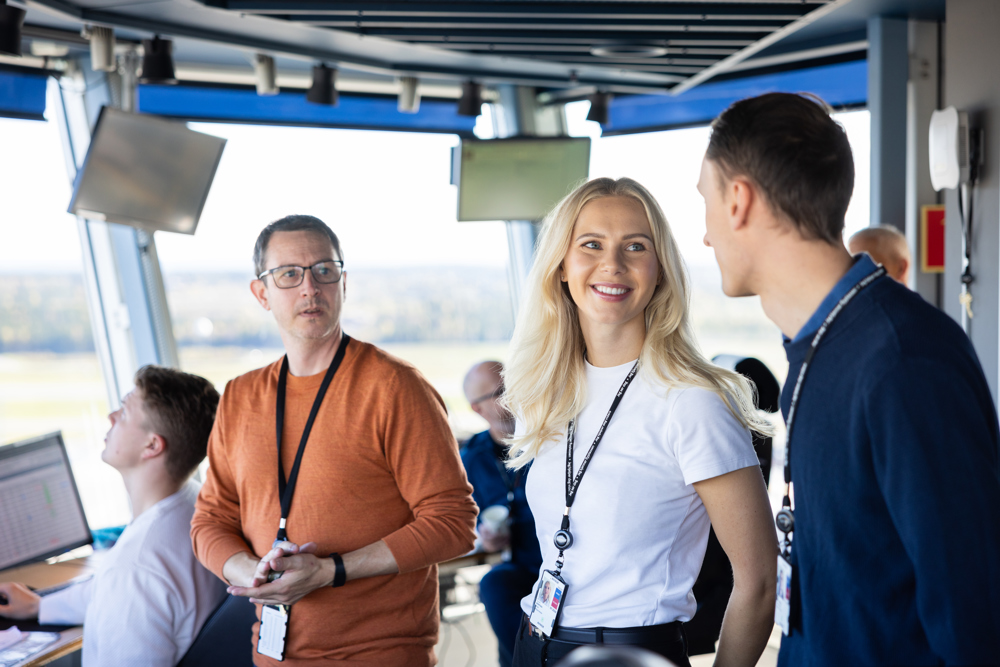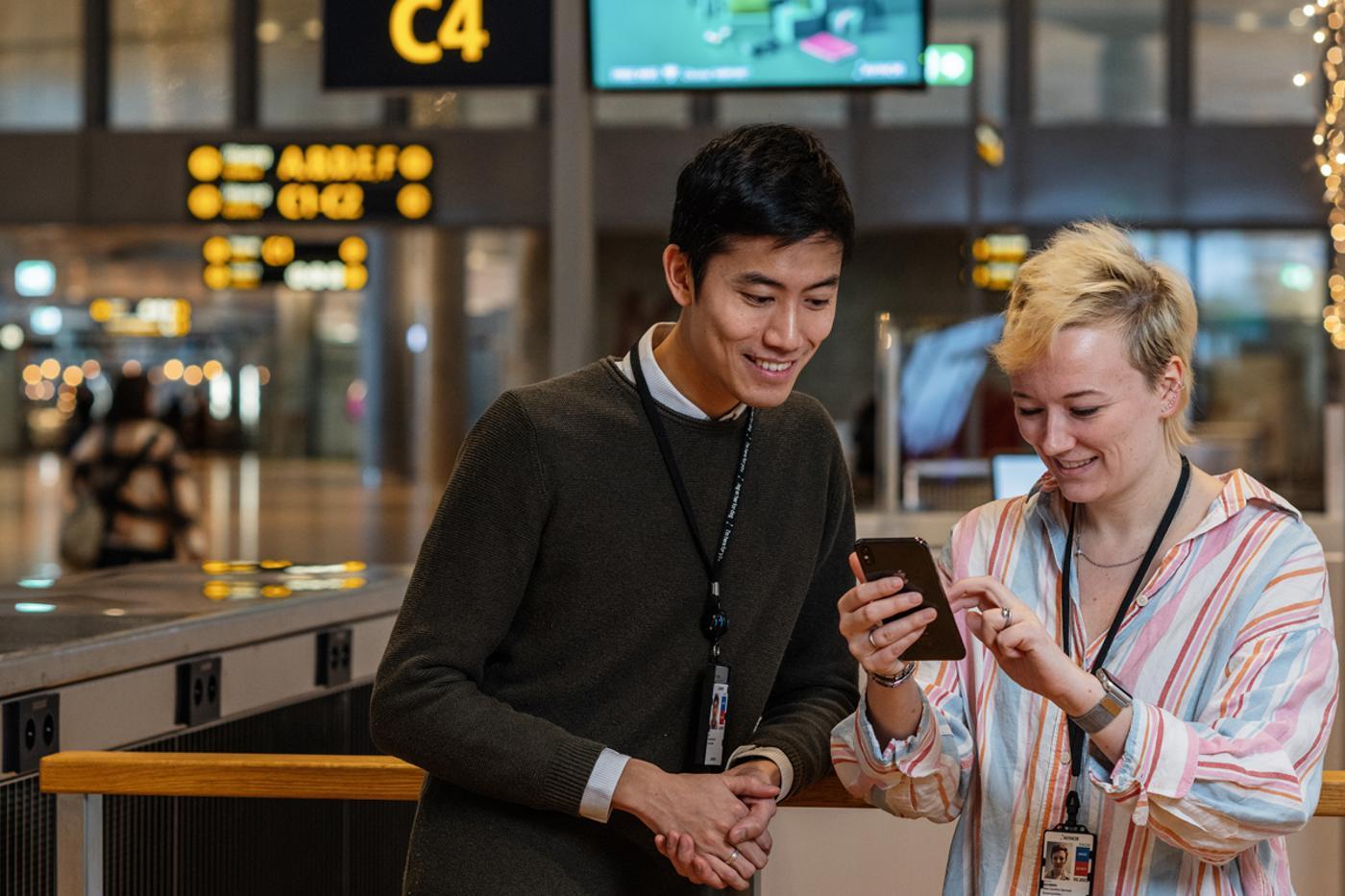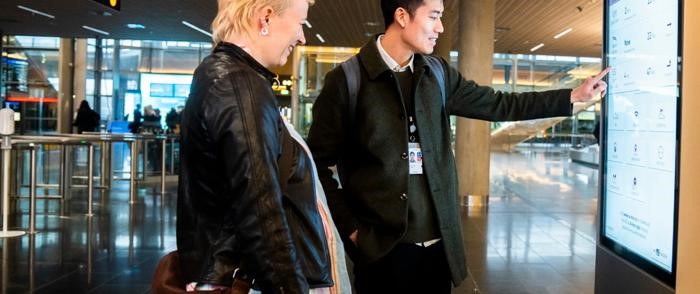
Want to work with us?
Are you curious to know more about career opportunities in technology at Avinor? Follow the link above and read more!
Caroline and George are two of those who give you predictability when you go out and fly, while André and John Håvard have their eyes on the air and ensure that the planes get there safely as they should.

50 million passenger journeys. 600,000 take-offs and landings. 50,000 overflights. It doesn't go around by itself. Now Avinor needs more smart minds. Are you one of them?

– Oh, look here! I have created this system. It's actually the first time I've seen it in full size.
Close to the baggage carousels at Oslo Airport, George Lee has spotted a screen. He works as a system developer at Avinor. Today, he and his colleague Caroline Jacobsen have made the trip to Oslo Airport to talk about the solutions they work with on a daily basis.
Now the two system developers are clicking around on the screen, which offers almost everything passengers need in terms of information – from how to get to Oslo the fastest way to where to find various services at the airport. The screen is well known, because as George himself exclaimed, he is the one behind the system.
Over the past year, Avinor has invested heavily in its technology division, which today appears as a unified and strong division. The people who work here are constantly pushing the boundaries of technology and dealing with the entire passenger journey from long before you arrive at the airport until you land safely at your final destination. George and Caroline work in the Digital Services department. There, they develop, among other things, websites, apps and solutions for parking and charging electric cars.
“Although what we do contributes to Avinor making money, our purpose is first and foremost to give people a better experience when they go flying. It is rewarding because the solutions are used by so many.”
Caroline Jacobsen, systemutvikler Avinor
Neither George nor Caroline have a traditional IT education, but they both have an interest in technology and coding.
Despite a flexible working day with the possibility of working from home, George and Caroline spend most of their working days in the office.
"That probably says a lot about the working environment. I think we are the nicest department to work in.
That comment from Caroline is challenged by André Hübert Johansen and John Håvard Wraalsen.
They are also system developers, but work in Avinor's air navigation service at Norway's largest control center in Røyken. Both highlight the good working environment as one of the best things about the job.
"It's a great environment," says André.
He has worked at Avinor for 14 years and has no plans to retire anytime soon.
"The fact that it is a socially useful and safety-critical job was the most important attraction for me. I came from a job as a game developer and wanted new challenges. I've really got that here.
Simply explained, André and John Håvard's job is to develop systems that are used by air traffic controllers to keep the planes separated in the air and ensure a safe and efficient journey through the airspace. They navigate a technology that changes at rocket speed, and it is therefore important to stay up to date.
Sustainability may not be the first thing you associate with Avinor, but a lot is being done here. Among other things, work is being done on electrification of aviation, and Caroline, George, André and John Håvard are all solving tasks that will make an otherwise grey industry greener.
"We are dependent on aviation, and then it is about finding the best solutions for how we can make it as sustainable as possible," says George.
"We do a lot of testing and contribute to electrifying the car fleet at the airports, among other things. I have also worked on developing an electric car charging system," Caroline adds.
In Røyken, too, they are working on solutions that can create greener aviation.
"Air traffic has a bad reputation, but Avinor is really taking action. Our contribution is efficient air traffic control systems. Among other things, we are working to optimize departures and landings, which leads to less fuel use," says André.
John Håvard goes on to say that the structure of the workplace allows the employees to cultivate each other's strengths.
"We are a good mix of graduates and experienced developers, and have an environment that gives both groups the opportunity to flourish. There is a high willingness to lift the newcomers, and a good arena for those with extensive experience to both contribute and learn new things.
"There is room to get, and take, responsibility for those who want it," André adds.
The location of the control center at Røyken and the proximity to the operational environment are also pluses in the book for both André and John Håvard.
"I wanted to work outside Oslo, and for me who lives in Bærum, it's nice to have a short travel distance to the queue," says John Håvard.
André adds that they have great flexibility with the possibility of working from home. And in the office, they can enjoy modern premises with large lab areas and a shared canteen.
"Not least, it is a safe workplace. Regardless of whether there are ten or 300 planes in the air, all technology must work.

Are you curious to know more about career opportunities in technology at Avinor? Follow the link above and read more!